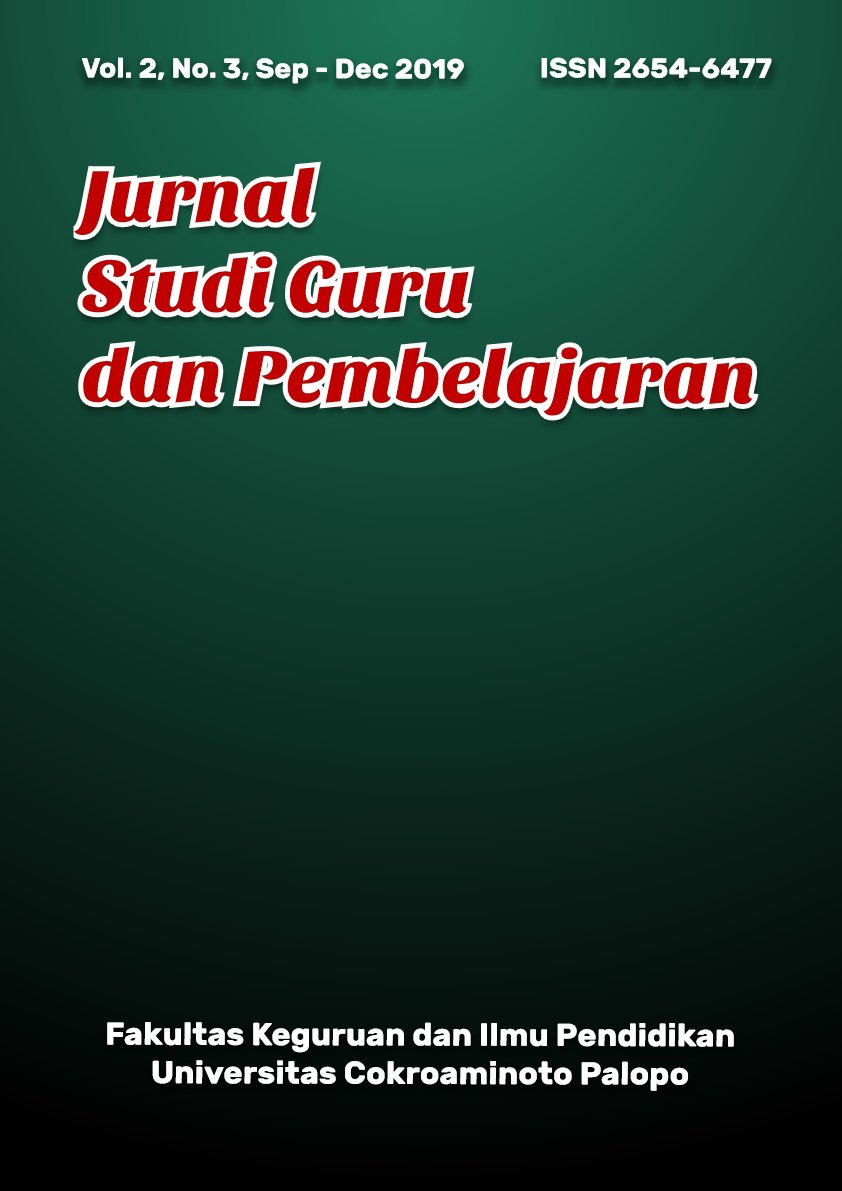The Application of Communicative Language Teaching to Improve Students’ Ability in Speaking
DOI:
https://doi.org/10.30605/jsgp.2.3.2019.55Keywords:
Communicative Language Teaching, Method, SpeakingAbstract
The purpose of this study is to investigate students’ ability in speaking before and after using Communicative Language Teaching in learning English. The method in this research was experimental quantitative method by using quasi experimental design with one group pretest-posttest model. The design only see students’ achievement in speaking before and after using Communicative language Teaching. The object of the research was English Department students. They were randomly selected. The technique of collecting the data was done through observation and the data were gotten from the students when they did oral communication. The instrument in this research was oral test. The data were analyzed by using Lilliefors test, testing homogeneity F, and testing hypothesis by using T-test. The result of this study shown that the use of Communicative Language Teaching could improve students’ ability in speaking. It was proved from the students’ average was higher after using Communicative Language Teaching. The data in this research had normal distribution. Based on data analysis by using T-test was gotten that tcount = 6,59 at the significant level = 5% and dk (n-1) = (30-1) =29 was gotten ttable = 1,699. So, tcount > ttable. It proved that Ho was rejected, and Ha was accepted. It’s meant that there was a significant difference between students’ ability before and after implementing Communicative Language Teaching.
Downloads
References
Arikunto, S. (2005). Manajemen Penelitian. Jakarta: Rineka Cipta.
Astuti. E. D. (2010). Meningkatkan kemampuan Percakapan Bahasa Inggris Siswa dengan Model Make a Match pada Siswa Tunarungu Wicara dan Tunagrahita VII SMPLB. JASSI_Anakku, 9(1), 66-75.
Badan Pengembangan dan Pembinaan Bahasa. (2005). Kamus Besar Bahasa Indonesia (KBBI). Jakarta: Balai Pustaka.
Brown. (2001). Principle of Language Learning and Teaching. New York: Prentice Hall.
Brown. (2004). Language Assesment Principles and Clasroom Practices. New York: Pearson Education.
Caganaga. (2014). The Effect of Communicative Approach on Learners Foreign Language Profiency Levels by Using The Need Analysis in English For Specific Purposes Classes. International Online Journal of Education and Teaching (IOJET), 1(2), 91-107.
Richard, J. & Rodgers T. (2007). Approaches and Methods in Language Teaching. Cambridge: Cambridge University Press.
Larsen. (2004). Techniques and Principles in Language Teaching. Oxford: Oxford University Press.
Stoner. G. M. (2009). Effectively Communicating With Visual Aids. Mattstoner. Net.
Sudjana. (2005). Metoda Statistika. Bandung: Tarsito.
Sudijono, A. (2007). Pengantar Statistik Pendidikan. Jakarta: Raja Grafindo Persada.
Sugiyono. (2012). Metode Penelitian Kuantitatif, Kualitatif, dan R & D. Bandung: Alfabeta
Uno, H. B. (2009). Model Pembelajaran. Jakarta: Bumi Aksara
Ur, P. (1996). A Course in Language Teaching: Practice and Theory. Cambridge: Cambridge University Press.
Yasin. (2017). Communicative Language Teaching for Teaching Speaking. English Education Journal (EJJ), 8(3), 322-337.
Downloads
Published
How to Cite
Issue
Section
License
In submitting the manuscript to the journal, the authors certify that:
- They are authorized by their co-authors to enter into these arrangements.
- The work described has not been formally published before, except in the form of an abstract or as part of a published lecture, review, thesis, or overlay journal.
- That it is not under consideration for publication elsewhere,
- That its publication has been approved by all the author(s) and by the responsible authorities – tacitly or explicitly – of the institutes where the work has been carried out.
- They secure the right to reproduce any material that has already been published or copyrighted elsewhere.
- They agree to the following license and copyright agreement.
License and Copyright Agreement
Authors who publish with JSGP agree to the following terms:
- Authors retain copyright and grant the journal right of first publication with the work simultaneously licensed under Creative Commons Attribution License (CC BY-SA 4.0) that allows others to share the work with an acknowledgement of the work's authorship and initial publication in this journal.
- Authors are able to enter into separate, additional contractual arrangements for the non-exclusive distribution of the journal's published version of the work (e.g., post it to an institutional repository or publish it in a book), with an acknowledgement of its initial publication in this journal.
- Authors are permitted and encouraged to post their work online (e.g., in institutional repositories or on their website) prior to and during the submission process, as it can lead to productive exchanges, as well as earlier and greater citation of published work.














